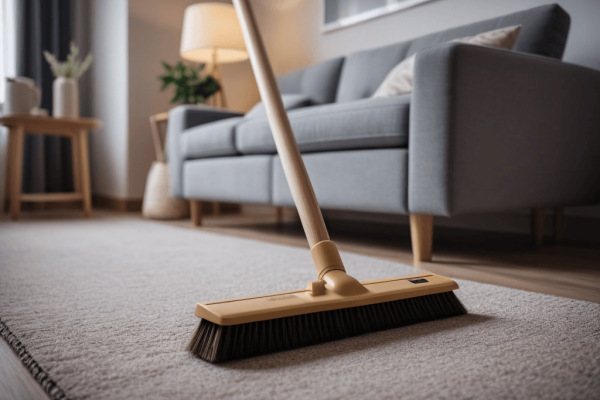A clean home brings comfort, clarity, and a sense of accomplishment. However, cleaning can often feel like a never-ending task, especially when it involves numerous products, tools, and routines. With simplified home cleaning rooted in minimalist habits, you can streamline your cleaning routine, reduce stress, and maintain a tidy home without spending excessive time and energy.
This article explores practical tips to help you adopt minimalist cleaning habits, covering everything from reducing clutter to creating a streamlined cleaning schedule.
1. Declutter First for Effortless Cleaning
Decluttering is one of the best steps you can take to make home cleaning easier and more effective. Excess items not only create visual clutter but also make it more challenging to clean your surfaces, floors, and storage spaces.
How to Declutter Efficiently:
- Focus on One Room at a Time: Starting with one room or area at a time allows you to see progress and stay motivated. Choose high-traffic areas like the living room or kitchen first, as decluttering these spaces will have the most noticeable impact.
- Sort Items by Category: Go through your belongings by category (such as books, clothes, or kitchen tools) and assess whether each item is essential. Items you don’t use regularly can be donated or discarded.
- Adopt the “One In, One Out” Rule: Every time you bring something new into your home, remove an item you no longer need. This habit helps prevent clutter from building up over time.
Pro Tip: Keep a donation box or bag in a central location. Add items as you come across things you don’t need, making it easier to donate regularly without a big decluttering session.
2. Create a Minimalist Cleaning Kit
One of the core principles of simplified home cleaning is using fewer, more versatile cleaning tools and products. With a streamlined cleaning kit, you can reduce clutter in your storage spaces and avoid using unnecessary chemicals in your home.
Essential Items for a Minimalist Cleaning Kit:
- All-Purpose Cleaner: Instead of buying separate cleaners for each area of your home, choose a gentle, all-purpose cleaner that works on various surfaces. This reduces the number of products you need and simplifies your routine.
- Microfiber Cloths: Reusable microfiber cloths are highly effective for cleaning multiple surfaces, from countertops to glass, and they can be washed and reused, reducing waste.
- Broom and Dustpan: A broom is essential for quick sweeps around your home, especially in areas where crumbs and dirt tend to gather.
- Vacuum Cleaner: Choose a lightweight, versatile vacuum cleaner with attachments that can handle various surfaces, including carpets and hardwood floors.
- Squeegee: A squeegee is perfect for keeping shower doors, mirrors, and windows streak-free without much effort.
Pro Tip: If you prefer DIY solutions, consider making your own cleaners using ingredients like vinegar, baking soda, and lemon. These natural ingredients are effective for many household cleaning tasks and reduce the need for multiple commercial products.
3. Adopt a Daily Cleaning Routine
A daily cleaning routine is a game-changer for maintaining a clean home with minimal effort. By incorporating a few quick tasks into your daily schedule, you can prevent dirt and clutter from piling up, making weekly or monthly deep cleaning sessions easier and less time-consuming.
Simple Tasks for a Daily Cleaning Routine:
- Wipe Down Surfaces: After each meal, wipe down kitchen counters and dining tables. In the bathroom, a quick wipe of the sink and countertop keeps things tidy.
- Do a 5-Minute Tidy Up: Spend five minutes each evening picking up items and putting them back in their proper places. This habit keeps clutter at bay and maintains a sense of order.
- Load the Dishwasher: Running the dishwasher daily prevents dishes from piling up and keeps your kitchen clean. If you don’t have a dishwasher, make it a habit to wash dishes immediately after meals.
- Sweep High-Traffic Areas: Quickly sweeping areas like the kitchen and entryway can prevent dirt from spreading throughout your home.
Pro Tip: Set a timer for 10–15 minutes each day and focus on cleaning just one or two tasks. This time-limited approach prevents cleaning from feeling overwhelming and allows you to stay consistent without spending hours each day.
4. Prioritize High-Impact Cleaning
Minimalist cleaning is all about focusing on tasks that make the most difference. Instead of trying to clean every corner of your home, identify high-impact areas that quickly make your space feel tidy.
High-Impact Cleaning Tasks:
- Clear Countertops: Keeping countertops clear of clutter instantly makes your kitchen and bathroom look cleaner and more organized.
- Make the Bed: A made bed brings a sense of order to the bedroom, even if the rest of the room isn’t perfect.
- Clean Mirrors and Windows: Clean, streak-free mirrors and windows enhance the light and atmosphere of any room, making it feel brighter and more inviting.
- Tidy the Entryway: Since the entryway is the first thing you and your guests see, a quick tidy-up here can make a big difference. Put shoes and coats in their designated spots and give surfaces a quick wipe.
Pro Tip: Every few months, assess which cleaning tasks make the most noticeable impact on your space. Focusing on these tasks first saves time and energy while still giving you a clean and inviting home.
5. Implement Storage Solutions for Easy Maintenance
Storage solutions play a significant role in a minimalist approach to home cleaning. When everything has a designated place, it’s easier to keep your home clean and organized. By maximizing storage in an intentional way, you can maintain a clutter-free space effortlessly.
Minimalist Storage Ideas:
- Use Baskets and Bins: Baskets and bins are great for storing smaller items that would otherwise clutter shelves or countertops. Use them to organize toys, office supplies, and pantry items.
- Opt for Multipurpose Furniture: Choose furniture with built-in storage, like ottomans or coffee tables with hidden compartments. These pieces help you keep items accessible but out of sight.
- Label Containers: Labeling containers and bins helps you easily find items and encourages family members to put things back in their designated places.
- Utilize Vertical Space: Don’t forget to use vertical space, such as shelves, hooks, or wall-mounted organizers. These are especially useful in small homes or apartments where floor space is limited.
Pro Tip: Regularly evaluate your storage solutions to ensure they’re still meeting your needs. Declutter as you go, removing items from storage that are no longer useful.
6. Embrace “Clean as You Go”
Cleaning as you go is a simple but effective habit that prevents mess from building up. It’s particularly helpful in areas like the kitchen and bathroom, where spills and clutter can quickly accumulate.
How to Practice Clean as You Go:
- Clean Up While Cooking: Wash dishes and wipe counters as you cook to keep your kitchen clean and avoid a large pile of dishes after meals.
- Pick Up After Yourself: Put items back immediately after using them, whether it’s in the bathroom, bedroom, or living room.
- Rinse the Shower: After each shower, give the walls a quick rinse or wipe down to prevent soap scum buildup.
Pro Tip: If you live with others, encourage everyone to practice the “clean as you go” habit. This ensures shared spaces remain tidy and makes cleaning a group effort.
7. Designate a Weekly Deep Cleaning Day
Even with daily cleaning habits, your home will still need occasional deep cleaning. By designating a specific day each week to tackle deeper cleaning tasks, you can keep your home thoroughly clean without overwhelming yourself.
Tasks for a Weekly Deep Cleaning Session:
- Dust Surfaces: Dust accumulates on surfaces like shelves, baseboards, and ceiling fans. A weekly dusting session keeps it from building up.
- Vacuum and Mop Floors: Thoroughly vacuum and mop all floors to remove dirt, dust, and allergens.
- Disinfect High-Touch Areas: Areas like light switches, door handles, and remote controls can harbor germs. Wipe them down with a disinfectant each week.
- Clean Appliances: Clean out the refrigerator, microwave, and other appliances that may have accumulated spills or crumbs.
Pro Tip: Use a checklist to stay organized and track your weekly tasks. This helps you complete each task efficiently and ensures nothing is overlooked.
8. Maintain Minimalist Decor for Easy Cleaning
Minimalist decor isn’t just stylish—it also makes cleaning easier. By limiting the number of items on display, you reduce surfaces that collect dust and make your home feel open and airy.
How to Keep Decor Minimal and Functional:
- Limit Decorative Items: Choose a few meaningful decorative pieces instead of filling every surface. This reduces the time you spend dusting and creates a cleaner look.
- Opt for Easy-to-Clean Materials: Look for decor and furniture made from materials that are easy to wipe down, such as glass, metal, or leather.
- Embrace Negative Space: Don’t feel the need to fill every wall or shelf. Leaving some space empty helps reduce visual clutter and gives your home a minimalist feel.
Pro Tip: Rotate decorative items seasonally instead of displaying everything at once. This keeps your space fresh and clean while reducing the amount of decor you need to maintain.
Conclusion
Simplified home cleaning through minimalist habits allows you to maintain a clean, inviting space without overwhelming effort. By first decluttering and creating an efficient cleaning kit, you eliminate unnecessary items and products, making your routine simpler and more manageable. Incorporating daily habits, focusing on high-impact areas, and storing items intentionally means you can stay organized without constant upkeep. Embracing minimalist decor and a “clean as you go” mindset further enhances the ease of cleaning. These small, intentional changes not only reduce stress but also give you more time to enjoy your home. With a streamlined approach, maintaining a clean home becomes part of your lifestyle, creating a calm, clutter-free environment you can appreciate every day.


